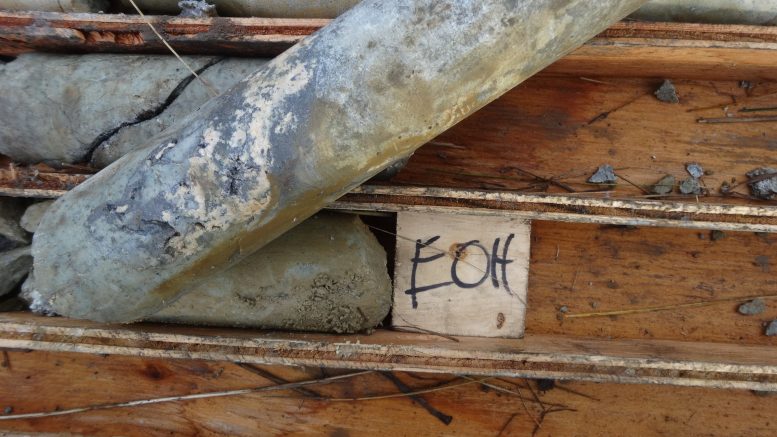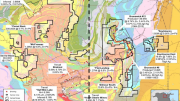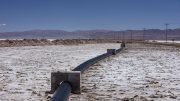VANCOUVER — New Nadina Explorations (TSXV: NNA) is the latest contender to join the ranks of junior explorers with surging market valuations, such as Novo Resources (TSXV: NVO; US-OTC: NSRPF), Metallis Resources (TSXV: MTS) and Garibaldi Resources (TSXV: GGI; US-OTC: GGIFF).
Shares of New Nadina skyrocketed 1,600% to peak at $2.25 after the company announced a 132-metre intercept of “high-grade core” containing bornite, sphalerite, galena and pyrargyrite — also known as ruby silver — while drilling at the company’s Silver Queen polymetallic property, 36 km south of Houston, west-central British Columbia.
The announcement on Oct. 25 was corrected two days later, at the request of the Investment Industry Regulatory Organization of Canada, with reference of “high-grade sulphides” removed from the text, with assays for the hole still pending.
Mineralization occurs as a stockwork of subvertical, low-silica veins up to 1.5 cm thick and spaced at 10 cm intervals from 663 to 795 metres deep. Based on visual observations, the company said the area of “interest” continues to the end of the hole at 816 metres deep. Core photos are available on the company’s website here.
Ellen Clements, the company’s president and CEO, tells The Northern Miner during a phone interview that she couldn’t be more thrilled with the results.

Historical and current drilling with location of Geotech EM and Quantec Geoscience TITAN-24 DCIP and MT anomalies noted in green and blue. Credit: New Nadina Explorations.
“We took a long shot, drilled a wildcat hole right off the bat — and we hit it,” Clements says with enthusiasm. “I knew it was a high-risk hole, but I had to get it out of my system because I had such a gut ache over it. It was a now or never sort of moment — I would’ve paid for the hole myself if I had to.”
The hole was targeting a deep conductive anomaly — called the Blue Zone — located east of the property’s No. 3 vein, one of the 22 epithermal zinc-silver-gold-lead veins that cut across the 70.5 sq. km property. The vein system, called the Wrinch, saw intermittent, underground production dating back to 1912, according to a B.C. Minfile.
Clements says the company targeted the anomaly believing it could be the enigmatic source of all the metal-rich veins at surface.
“When the geophysicists were conducting their survey, they were charging up to shoot the line but the machine kept stalling … at the time, the operator thought there was either something wrong with the equipment, or the ground was so conductive it was sucking the juice out of the equipment. They said they have never seen that happen in B.C. before, only in Cobalt, Ontario. But now we know that it was the ground, and not the machine,” she says.
(The Cobalt district in Ontario produced 442 million oz. silver between 1903 and 1966, making it one of the largest silver-producing areas in the world, only exceeded by Potosi in Bolivia and Butte in Montana, and greater than Guanajuato in Mexico.)
“There are veins all over the place at Silver Queen, and they must have leaked out of something at depth,” she says. “We found a porphyry in 2011, but we know it’s not the source. The porphyry is crosscut by these high-grade silver veins that came much later — one of them ran 5.5 metres of 1,581 grams silver per tonne and 3.15 grams gold per tonne.”

A drill rig at New Nadina Explorations Silver Queen polymetallic property in west-central British Columbia. Credit: New Nadina Explorations.
Clements says the deep geophysical target was missed by previous explorers, with one exception: a hole drilled by Northgate in 1970, which hit 1.7 metres of 769 grams silver, 12.2% lead and 27.2% zinc at 437 metres deep.
The hole is interpreted to have intercepted a thin sliver of the anomaly, 400 metres southwest of New Nadina’s current drilling.
“It’s quite a ways away, but it looks like it’s at the right depth and has the same quality of mineralization,” she adds.
New Nadina is drilling its third and last hole on the target, after which the company will pursue financing and make plans for more drilling in the new year.
Clements noted that getting access to the property has been a problem in recent years due to opposition from a local rancher. This private owner bought the land over New Nadina’s Crown-granted mineral claims in 2001 and 2009, and inhibited the company’s access since 2012.
In May, New Nadina received the right-of-entry order from the Surface Rights Board of British Columbia, which allowed the company to drill, provided it does so with minimal disturbance.
“We’re limited on the number of holes we can drill right now, but it’s no problem, we can drill it from the north on Crown land,” she says. “All we have to do is drill enough holes from surface to warrant going underground.”
Clements, an accountant and avid prospector, replaced her husband, George Stewart, as New Nadina’s president and CEO after his sudden passing in 2005.
She says that Stewart had a long history at Silver Queen, having worked there with Kennco in the late 1960s, and was passionate about exploring for any deeply buried source of metals found at surface.
So when Clements took the helm of the company in 2006 she visited Bill McCrae, a former president of New Nadina, for advice on what to do.
“Bill said to me, ‘You don’t need to do it. You should just find yourself a boyfriend, go off into the sunset and enjoy your life,” she says. “But what I heard was, ‘a lot of smart people have looked at this property, how are you going to find anything they couldn’t?”
Within 10 minutes she made up her mind: she was up for the challenge.
“The Silver Queen is a female, and you have got to think like a female to figure out where her treasures are, because she hid them really well,” she says. “When I looked through all the reports and what was done, all the good people that should have found it had lost focus at some point. So every day I reminded myself to stay focused and let faith help me.
“There has been a lot of laughter, tears, consoling and condolences about George not being here to witness this. This has been a long haul for all of us. We have some very loyal shareholders and I just want the best for them.”
Shares of New Nadina have traded in a 52-week range of 8¢ to $2.25, and closed at $1.75 at press time. The company has 13.93 million shares outstanding for a $24-million market capitalization.






Be the first to comment on "New Nadina hits potential discovery at Silver Queen in BC"